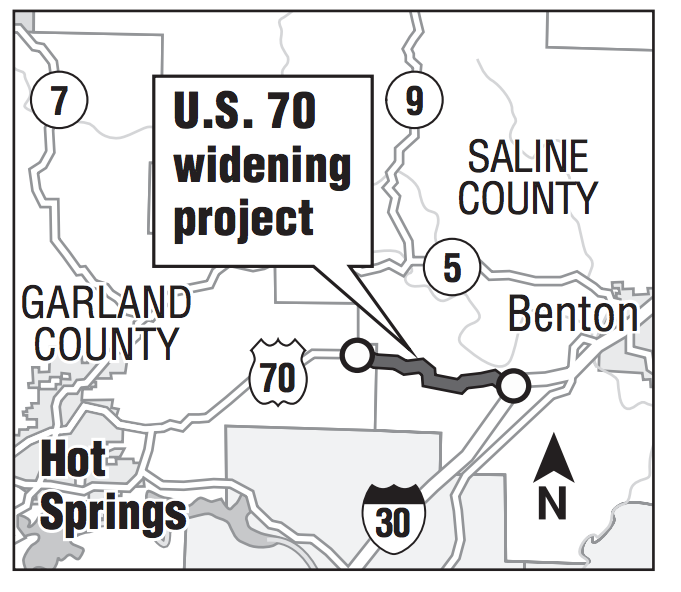Highway construction in Garland County is about to begin to catch up with the county's population growth.
In December, bids are expected to be opened on a project to widen U.S. 70 from Interstate 30 in Saline County to Hot Springs, the Garland County seat and one of the state's premier tourism destinations.
The project covers 19 miles and, when completed by 2019, will transform the largely two-lane road, which has been the scene of several fatal crashes in recent years, into a five-lane thoroughfare.
Next year, the Arkansas Highway and Transportation Department will begin preliminary work on building a new north-south bypass by extending U.S. 270 from U.S. 70 to Arkansas 5 on the east side of Hot Springs.
And in 2018, the agency is expected to do some widening, straighten out some curves and flatten some hills on Arkansas 7 between Hot Springs and Arkansas 5.
County Judge Rick Davis of Garland County said the work is overdue.
The projects, particularly improvements to Arkansas 7 and development of the bypass, will address traffic congestion brought on by population growth in the Arkansas 7 corridor from Hot Springs up to Arkansas 5 and on into Hot Springs Village.
"There's a massive amount of traffic going through there," Davis said last week.
The increased population north and east of Hot Springs is complicating travel in that part of the county for law enforcement personnel, emergency responders such as fire and ambulance crews, and tourists, he said.
The county's estimated population now is 97,177, according to the latest figures from the U.S. Census Bureau. That is up from 73,397 in 1990.
Hot Springs is home to a thoroughbred racetrack, Oaklawn Park, and is part of a national park.
The U.S. 70 project between Benton and Hot Springs is part of the state's Connecting Arkansas Program, which is a $1.8 billion construction program aimed at corridors of regional significance. The program is financed in large part by a half-percentage-point increase in the statewide sales tax. The increase, which is in place for 10 years, was approved by voters in 2012.
The widening project is designed "to enhance the transportation connection between the cities, increase capacity, and improve traveler safety," according to the department.
While improving U.S. 70 has been a long-sought goal, improving the 6.2-mile section of Arkansas 7 between Hot Springs and Arkansas 5 has been under study for several years, as well.
The Arkansas Highway Commission approved studying the section in 2011 and earlier this month accepted the study's findings.
The study's conclusion? While improvements can be made to the route, the ultimate answer for traffic in that part of the county is the bypass.
The problem is that improvements to Arkansas 7 are restricted by the presence of historical structures and the national park, especially in Hot Springs, according to the study.
The highway also is part of a state scenic byway. In fact, Arkansas 7 from Arkadelphia to Harrison became the state's first scenic byway in 1993.
Because it's a scenic byway, whatever improvements are made "should allow for drivers to observe and enjoy the route, as well as provide access to local businesses and attractions for byway travelers," the study said.
In the end, the department limited its initial proposed improvements to a section of Arkansas 7 closer to Arkansas 5, outside the constraints of the city and the national park.
"It is an ongoing conversation we're having" with the city and the Tri-Lakes Metropolitan Planning Organization, which is responsible for long-range transportation planning for the Hot Springs area, said Danny Straessle, the Highway Department spokesman. "There are some additional ideas they would like to see happen in the corridor.
"It could evolve into something else. It's not finite. It's a living, breathing structure."
The department has set aside $10 million for 2018 to widen Arkansas 7 to three lanes from Fox Pass Cutoff, which is just north of Arkansas 7S, to Arkansas 5.
But the study said any improvements made to Arkansas 7 won't relieve the need for the bypass, which will further help if Arkansas 7S is closed as the National Park Service would prefer to see happen, according to the study. Arkansas 7S is a highway spur running through part of the park between U.S. 70 and Arkansas 7.
Projected traffic on the bypass in 2034, which is the project's design year, would increase to 11,500 vehicles daily from 9,000 vehicles daily if Arkansas 7S remained open.
The department said it wouldn't proceed without the county sharing in the cost of the project, which is estimated to be $60 million.
In June, Garland County voters approved extending a 0.635 percent sales tax, the proceeds of which will be used to provide up to $30 million toward bypass construction.
In addition, the county is putting up $5 million toward design and other preliminary work on the bypass next year, according to Straessle. The department also is going to tap $4.6 million in federal money afforded the region for congestion mitigation and air quality.
The voter initiative will help on other projects in the city and county, as well, Davis said.
"Just about every major road in Garland County will see some work," he said. "These improvements are for years of growth we already have."
Metro on 10/31/2016

